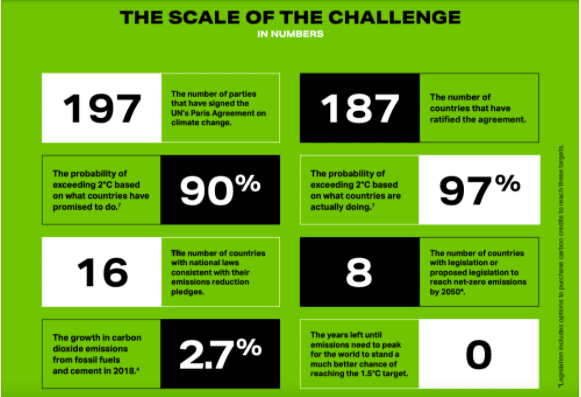
A possible but challenging imperative, climate neutrality has to transition from concept to reality now. The planet needs us to talk less and do more if we’re going to come close to achieving the 2050 deadline outlined in the Paris Agreement.
On February 10th, Polestar and Tortoise Media gathered media, industry stakeholders, and environmentalists to examine the challenges and opportunities surrounding climate neutrality at a live, digital event entitled: “Net Zero: from talk to action – what really works?”
Present to discuss Polestar’s efforts towards net-zero, Head of Sustainability, Fredrika Klarén was joined by climate and cleantech thought leader Diana Fox Carney, co-founder of Exponential Roadmap, Johan Falk, and moderator, Giles Whittel.

Why offsetting isn’t enough
On paper, the journey to net-zero appears simple. We need to halve emissions by 2030, and then halve them again… and then again. This equates to a 7% year-on-year reduction. Minimum.
The discussion of how this is achieved turned to the current big business trend of offsetting emissions or balancing CO2 emissions by investing in other green initiatives like planting trees. The problem is, this allows companies to talk up their green credentials while clinging to a carbon-intensive status quo.
Referencing the 1.5°C Business Playbook – a guide helping companies to create an effective strategy for halving their emissions by 2030 – Johan Falk reminded companies that they have to clean up their own operations before investing in nature-based climate solutions outside their value chain. This means cutting operational emissions and initiating your own sustainable solutions before buying trees or throwing money at the problem.
Diana Fox Carney agrees. It can never be just enough. Decarbonising needs to go as far as manually removing residual emissions. Because once we can successfully eliminate dispersed carbon dioxide from the air, things like long-haul aviation become viable.
Offsetting will definitely play a role in reaching net-zero, but climate neutrality cannot be bought. Companies today should not claim that their product is in any way climate-neutral until it actually is. From design to end-of-life.

Transparency is the only way forward
No stranger to being the “human reality check” for large corporations, Klarén believes the way forward lies in building climate agendas that are fully transparent, “EVs are an amazing technology that can be utilized today. But they are not perfect.”
Every product today goes to market with an environmental debt, and Polestar cars are no exception. However, when you consider that electric vehicles have the potential to be carbon neutral and traditionally fuelled cars don’t, a dot of light appears at the end of the emission-filled tunnel.
At Polestar, we’re not trying to hide the amount of work still to be done. Nor are we busy smashing self-defined benchmarks. Our Life Cycle Assessment reports document the environmental impact of our products, as well as the methodology used to measure said impact, and anyone can access them.
We want our consumers and employees to know what they’re buying into.
Make climate your business
On the subject of accountability, Falk maintains that rich countries, companies, and individuals should be leading the way. From a consumer perspective, greener choices are often more expensive, and no one is denying that technological progress can be pricey.
He also concludes that because governments are moving too slowly, the bulk of the work will fall to businesses. But even here we see leadership absolving themselves of responsibility.
The Tortoise Responsibility 100 Index compares the FTSE 100 companies to each other based on social and environmental policies. And while figures do show that significant efforts are being made, not enough have climate strategies that align with the 1.5°C Paris Agreement. The report also highlights that only five out of the top 100 companies are incentivizing or rewarding senior management for environmental (non-profit-based) performance.

The clock is ticking for fossil-based business
On a positive note, and contrary to boardroom beliefs, trends show that companies with climate in their business DNA will start to outcompete fossil-based organizations.
Reaching carbon neutrality will be critical to every company’s survival, whichever way the pendulum swings, but how can we take the first steps? Johan Falk says “make an estimate of your emissions, set targets, and get moving.”
The Exponential Roadmap – an Initiative that brings together innovators, scientists, companies, and NGOs, with the mission to halve emissions before 2030 – stresses that climate requires a holistic approach. Everyone needs to overhaul their value chains and re-engineer business models. Polestar is an open book when it comes to traceability and transparency, enabling it to stay accountable for the change it’s committed to making.
Fossil pathways will close this decade anyway, so businesses must look at the practicalities, change what can be changed quickly, and take it from there. Those that do it sooner will succeed.
Electrify the revolution
A truly innovative business will always find success in new solutions, and Fredrika Klarén feels Polestar will be a leader on the automotive front line.
“This is our opportunity to drive the electric revolution with transparency as a keyword. If we start with greenwashing now, we set ourselves off on the wrong path and risk losing customer trust.”
An EV isn’t carbon neutral yet, but charge it with renewable energy and it has half the impact of an equivalent ICE vehicle. Car for car, this aligns with the current 1.5°C ambition. But there is still lots to be done to meet the next deadline.
What you can do
When asked for tangible calls to action, Klarén called for an industry-wide revolution. She urged leaders to stop investing in legacy technologies and called on consumers to demand information and utilize their buying power. Internally, employees need to create a speak-up culture and be unafraid to question non-transparency.
While the road to climate-neutrality might not be clearly mapped, we have to resign to navigating en route. The race to net-zero has begun, and it’s one we cannot afford to lose.
Get the TNW newsletter
Get the most important tech news in your inbox each week.





